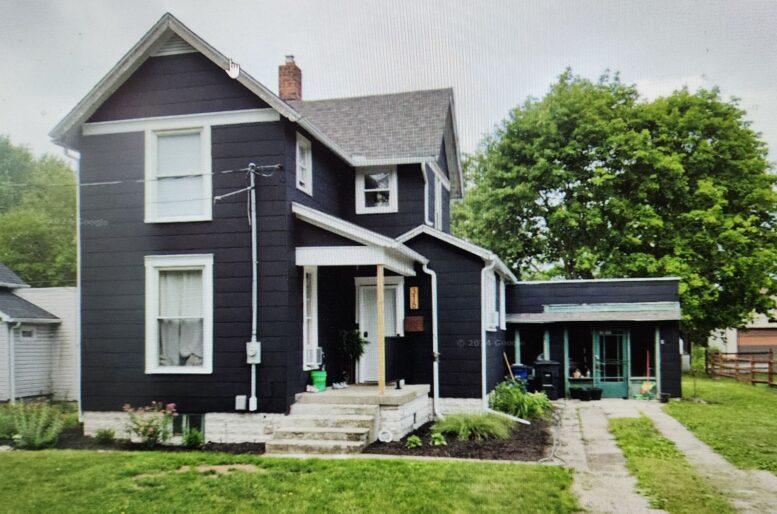Written by Geoff Howes
Bowling Green Historic Preservation Commission
In June, the Bowling Green Historic Preservation Commission begins a recurring series that will recognize neighborhood groceries of the past as Historic Buildings of the Month. The stores may be gone, but the buildings still stand, and the local markets live on in the fond memories of many longtime Bowling Green residents.
The first in the series, one of the oldest neighborhood markets, was at 316 Buttonwood. The former store—now a garage—can still be seen on the north side of the house toward the rear. The grocery that many still remember as Dillon & Moscoe was originally just Dillon’s, opened around 1934 by Harry G. Dillon.
Dillon, born in 1877, came from Belmore in Putnam County to Bowling Green, where he was a familiar figure from the 1910s until his death in 1951. He was a clerk in Frank M. Coen’s store on South Main Street in 1913 when Coen sold the store and recruited Dillon and his fellow clerk Roy B. Eberly as partners in the new Ceylon Tea Co. grocery on West Wooster Street.
The 1914 phone book lists Dillon as a proprietor of the Ceylon Tea Co., living at 419 S. Grove. But in August of that year, Coen bought out his partners Dillon and Eberly and moved the Ceylon stock to a larger store on South Main that he had purchased from F. E. Whitker. Dillon and Eberly stayed on as clerks.
Dillon worked for Frank Coen until 1918, when he took up farming near Weston with his wife Myrtie. On Oct. 7, 1918, only two months after the move, Myrtie died in childbirth and the child, named June, died too. In April 1919, the Wood County Democrat reported that Harry Dillon had moved back to Bowling Green and was employed at McCrory & Munn’s South End Grocery at 336 S. Main (now Newlove Realty). Later he worked at Shawaker’s Grocery at 149 E. Wooster, where Nate & Wally’s Fishbowl is now.
In 1925, the Wood County Republican announced that Dillon had resigned as a clerk at Shawaker’s to be with his mother in Belmore. In 1929, at age 51, he married Daisy Beverstock, 47, the widow of Edward Beverstock, who had died in 1920. After multiple moves and jobs, Harry was settling down. In the 1932 phone book he is listed as living at 316 Buttonwood. In 1934, a list of stores in the Wood County News included a grocery there under his name, and the 1935 city directory shows Harry and Daisy Dillon as proprietors. In 1947, the store was listed for the first time as Dillon & Moscoe, and the street guide indicates that J. H. Moscoe was also living at 316 Buttonwood.
J. Homer Moscoe, born in 1902, was a high-school basketball star in his hometown, Potsdam, New York. Basketball brought him to Bowling Green State Normal College in 1922. A first-string forward, he also played baseball and football. The local newspapers from 1922 to 1926 are full of his exploits on court, diamond, and field. Even as a freshman, he was on the college Social Committee and an athletic letterman. In his junior and senior years, Moscoe was captain of the basketball team.
After earning a BS in Education in 1926, he went on to teach in Sylvania schools. In July 1927 he married June Beverstock, also a BG Normal College grad, and the daughter of Daisy Dillon from her marriage to Edward Beverstock. The next year, Homer and June had their first and only child, Marilyn Jo (1928-2020).
The 1930 Census shows Homer, June, and Marilyn living on Monroe Street in Sylvania. The 1940 Census lists them on Maplewood Street in Sylvania. By then, Homer was no longer a teacher, but an assistant bank cashier. The next trace of him comes in 1947, when he was living on Buttonwood in Bowling Green as a partner in the grocery business with Harry Dillon and Daisy Dillon, his mother-in-law.
Harry Dillon died in 1951. In 1952, Daisy Dillon was still listed as a resident of 316 Buttonwood, but she died on Sept. 15 of that year. The Moscoes kept the name Dillon & Moscoe and continued running the grocery until it closed in 1974, after which they stayed in the house.
Homer died in 1990 and is buried in Oak Grove Cemetery. June sold the house in 1997 and passed away in 2006, at age 99. She is buried next to Homer.
Public records are all we have to attest to the partnership of the Dillons and the Moscoes. Aside from the family ties—Homer was Harry’s stepson-in-law—it may be that Harry recognized in Homer a young man like the one he had been, who after showing great promise had a hard time finding his way. The grocery store was an opportunity for success.
By all accounts, Homer and June were very popular storekeepers, beloved by the kids in their neighborhood. It seems the former sports star, teacher, and bank cashier found his calling in taking care of his neighbors.
Several members of the Historic Bowling Green Facebook group recently shared their memories of the Dillon & Moscoe market. (Those listed by their full names gave permission to be quoted.)
Randy asked: “Does anybody remember the little carryout on Buttonwood Ave.? … It was basically a two-car garage if I remember right. I remember going in there only a couple times with my mom in the early 70s.”
Kathy (Spears) Bechstein: “Dillons! Owned by Homer and June Moscoe. Many of the owners of our little stores had a hand in our lives that many of the kids today will never know.”
Laurie Hind: “Dillon’s was our go-to shop.”
Diane Sears Gibson: “Sweetest people ever. My mom used to send me there with a quarter to buy a loaf of Wonder Bread and I could use the change to buy some penny candy. I still remember the exact layout of that store! Great memories!”
Margaret: “Homer and June were amazing!”
Betty Lynn Feller: “Yes!! Dillon’s! I loved that place!”
Sue Kepling: “We lived a block down and they had the best penny candy.”
Bob Feller: “Remember the gumball machine with striped and spotted gumballs?”
Diane Sears Gibson: “I do remember the pop machine right inside the door, and the freezer with the ice cream!”
Julie: “Dillon’s—I probably bought about a cubic ton of candy, gum and popsicles.”
Carolyn: “Yes, it was Dillon’s. They always had kittens. Used to go there all the time.”
Susanne: “Used to walk there often. We lived on Pearl Street. I agree, very nice couple!”
Jim Freeworth: “It was there in the ‘70s too. Walked there too many times to count. They were very nice to all of us kids. I remember it as Moscoe’s.”
Jan: “Went to Dillon’s when I was a kid and then my girls went as we lived on Buttonwood.”
Bob Feller: “June and Homer Moscoe had a profound effect on my youth.”
Janilyn Dennis: “What would we have done without Dillon’s!”
Anyone wanting to nominate a historic building or site for recognition may do this through the city website at – https://www.bgohio.org/FormCenter/Planning-13/Historic-BuildingSite-Nomination-Form-83
Learn more about the Historic Preservation Commission by attending meetings (the fourth Tuesday of each month at 4 p.m.) or by visiting webpage at – https://www.bgohio.org/436/Historic-Preservation-Commission.

